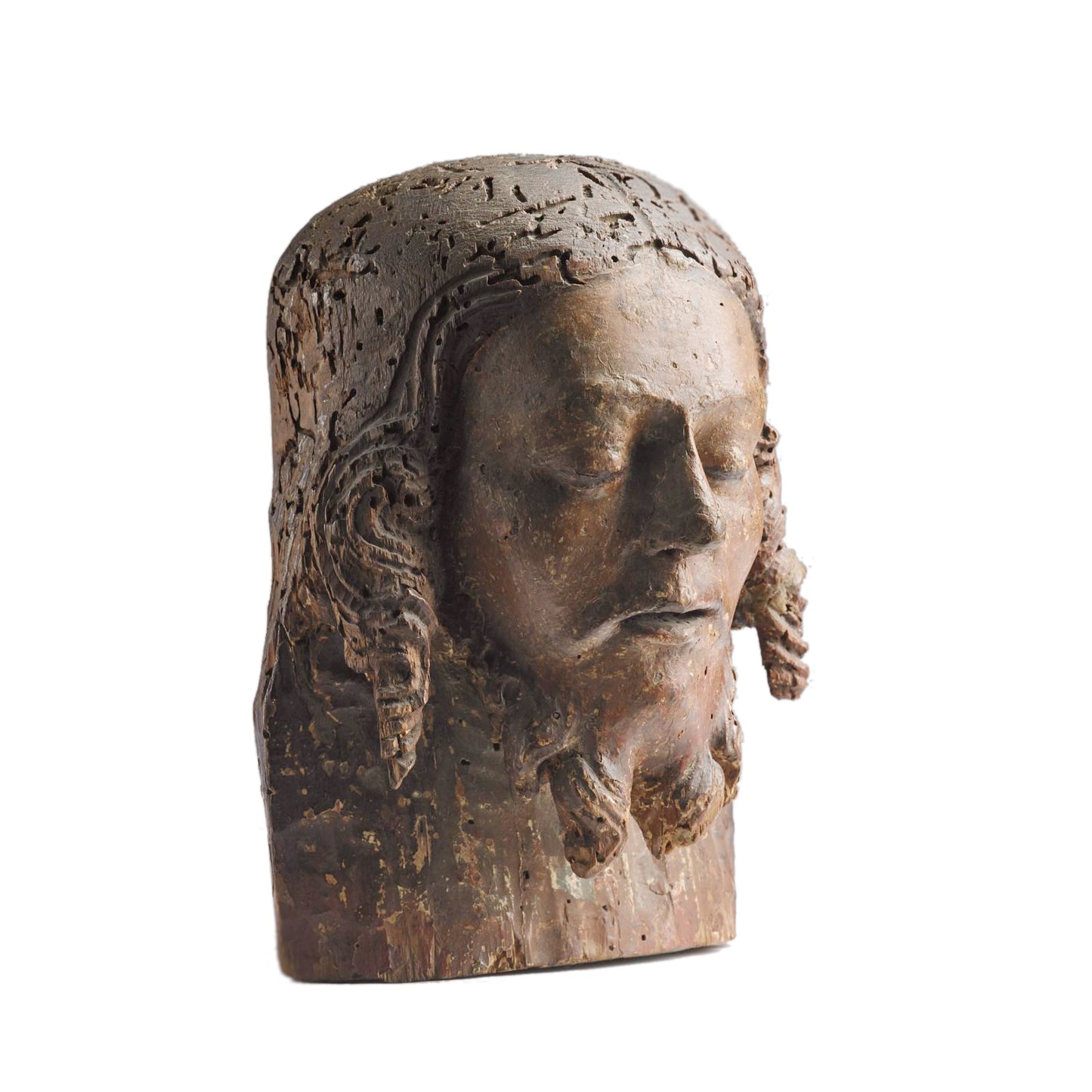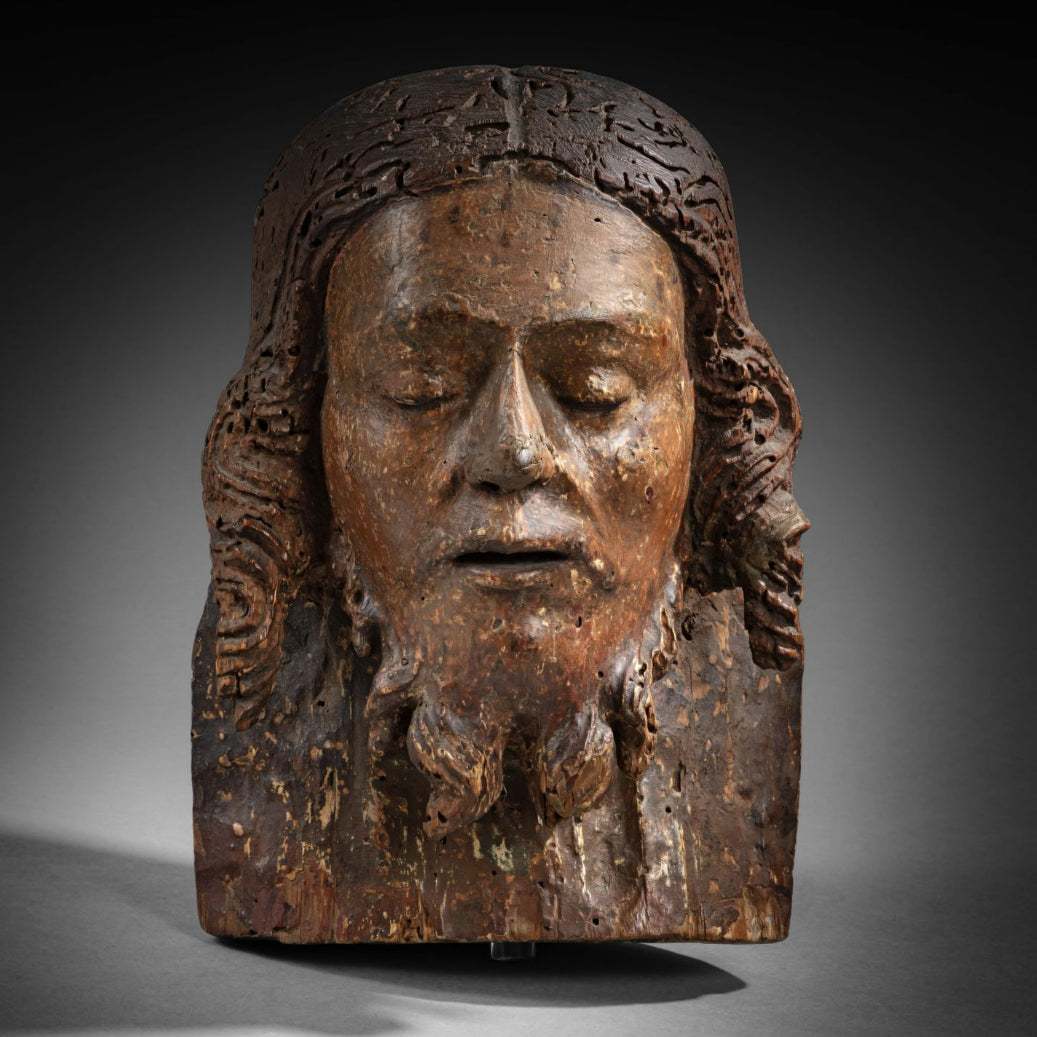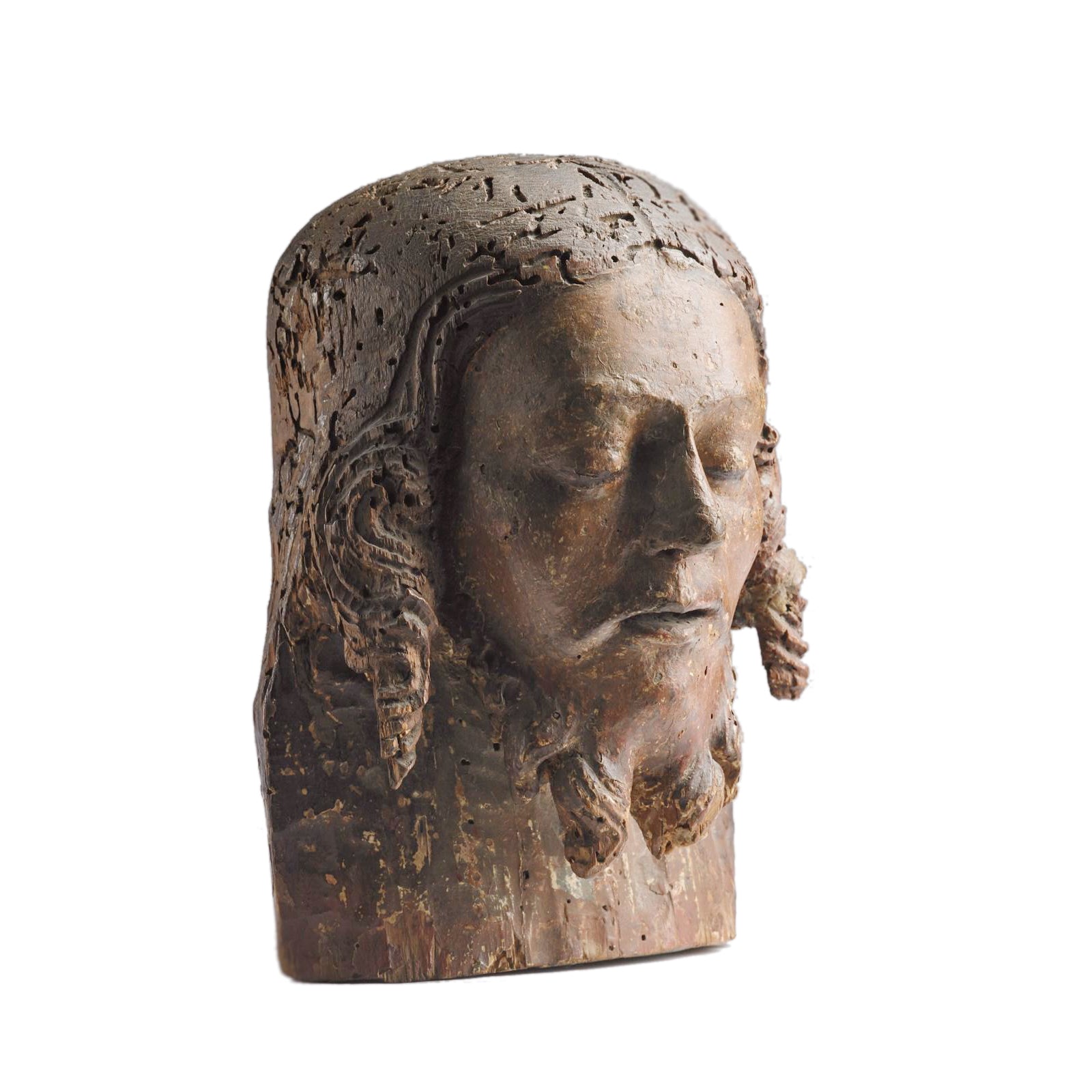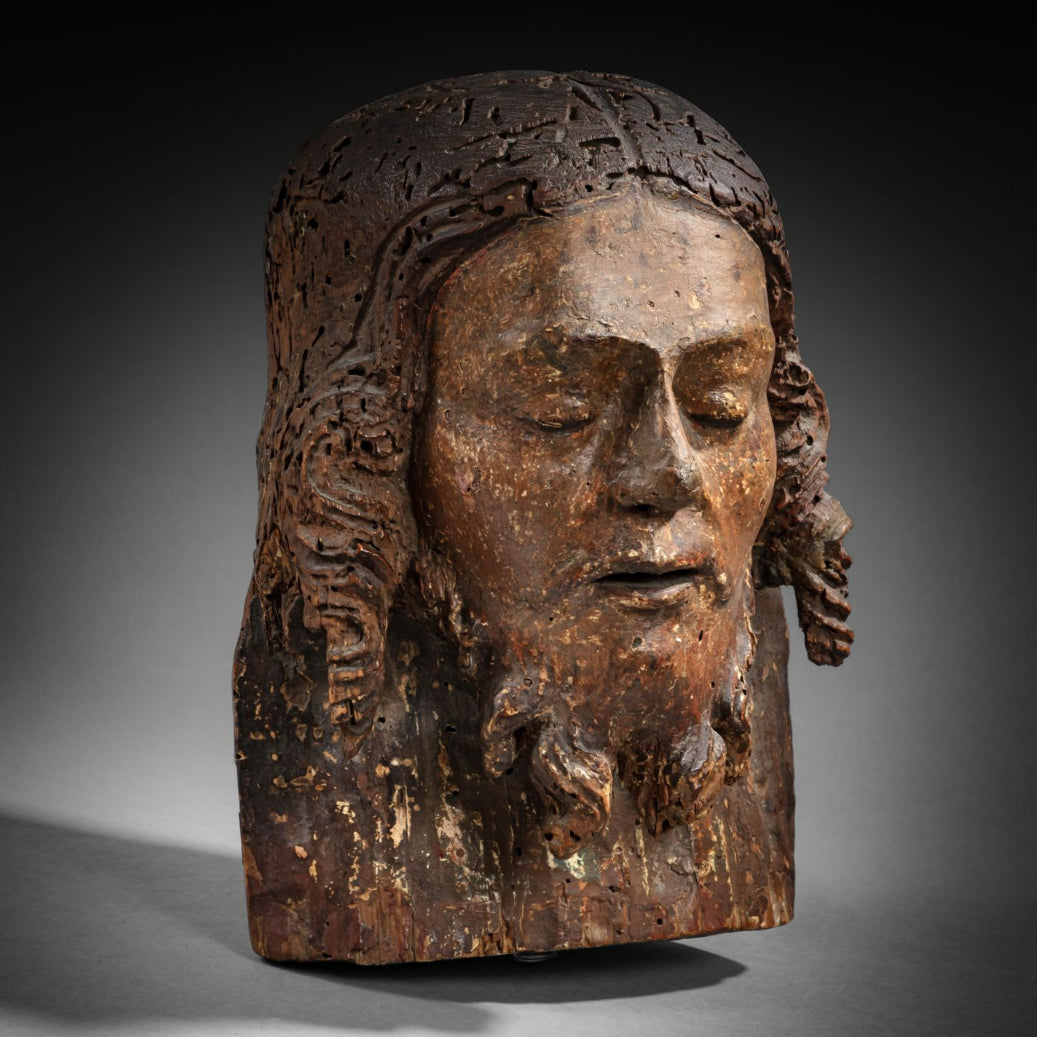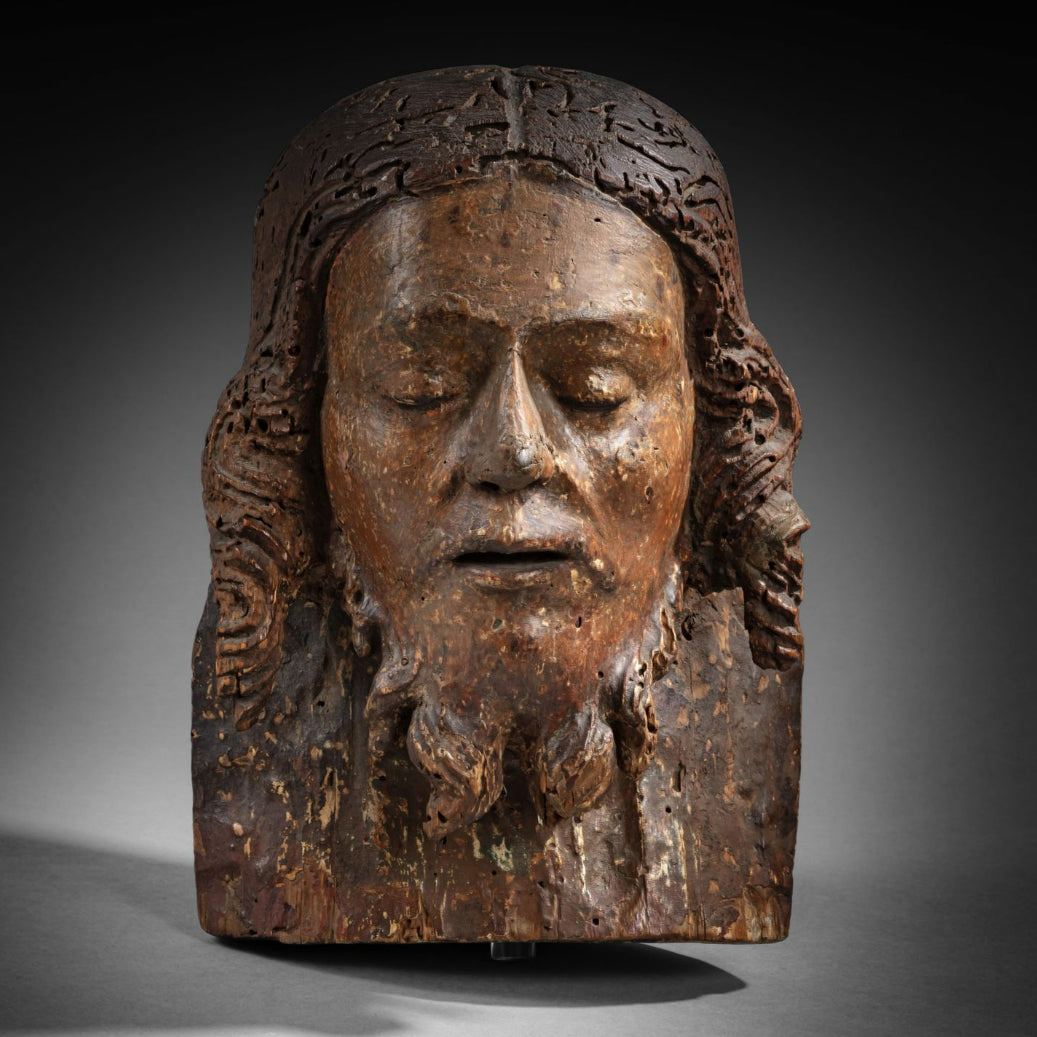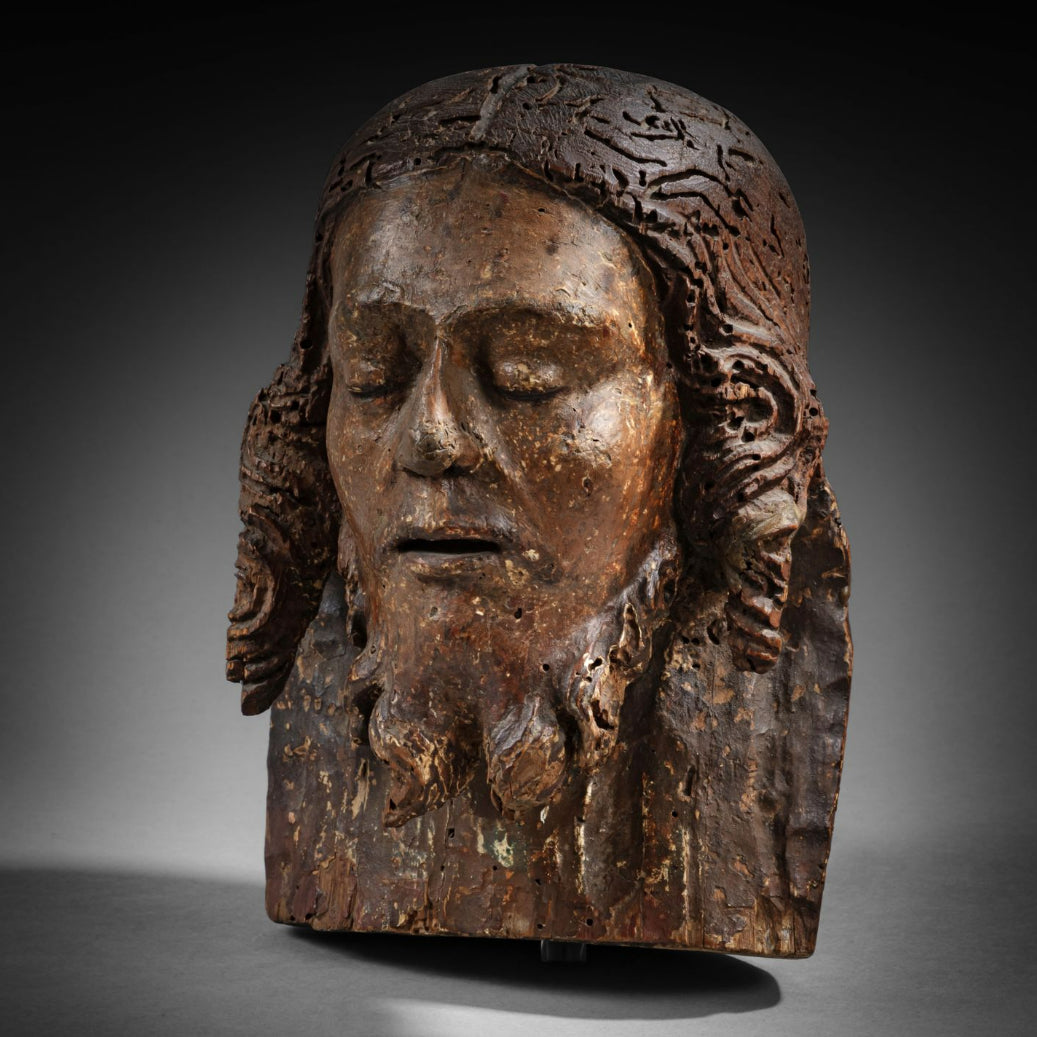Old World Wonders
15th century Florentine Sculpted Wooden Head of Christ
15th century Florentine Sculpted Wooden Head of Christ
Couldn't load pickup availability
Head of Christ, fragment of a Lamentation group
Possibly Maiano Workshop - Giovanni da Maiano (d. 1478) (?)
Florence, Italy; probably late 1460s or early 1470s
Presumably limewood; approximate size: 16 x 24 x 6 cm
This pleasantly conceived sculpture gracefully captures the effigy of Christ expired with its serene soulfulness that is both striking and convincing. The spiraling locks of hair framing Christ’s lower face are in eloquent balance with the terminating curls of his beard and the overall management of the sculptor’s hand implies a talented maker.
The present head of Christ is distinctively Florentine in essence, datable to the last third of the 15th century. Devotional art in Florence was in significant demand during the Quattrocento, destined for use in private chapels, oratories and convents in Florence and outlying areas. In the latter part of the century, Florence boasted more wood-carvers than butchers, being a testament to the value placed upon the desire for sacred art in that city. A majority of commissions were realized by Florentine artists like those belonging to the Maiano and Sangallo dynasty of sculptors as well as individual sculptors and their studios like Leonardo del Tasso, Baccio da Montelupo, Antonfrancesco Bugiardini, Baccio d’Agnolo, Francesco Rustici, Andrea Sansovino, the Master of the Scapigliati Crucifixes, et al.
Specifically, our sculpture represents a fragment for what would have formed the full figure of Christ belonging to a compianto or Lamentation group of free-standing sculptures executed in wood, modeled further in stucco and painted in vibrant color. The figure of Christ would have been shown reclined, laid supine on the floor or stage and surrounded by mourners. Other such groups, were executed in-and-around Florence like those observed realized in terracotta by Michele da Firenze (Galleria Estense)one attributed to Leonardo del Tasso, ca. 1490 (Berlin Museums), or another in the ambit of Baccio da Montelupo, ca. 1515-20 (Museo d’Arte Sacra di San Francesco di Greve in Chianti).
In particular, our head of Christ aligns with the milieu of works produced by the Maiano brothers whose workshop the elder brother Giuliano owned and established along Via de’ Servi during the 1450s. Alongside Giuliano were his two younger brothers, Giovanni and Benedetto, the latter of whom became a much-respected and distinguished sculptor during the last part of the 15th century.
The distinctive tubular corkscrew curls present on the hair and beard of our Christ are superficially analogous with those belonging to a crucifix ascribed to Giuliano da Maiano or his ambit at the Cardini Chapel in the Church of San Francesco in Pescia while the overall disposition of Christ’s face is reflective of crucifixes by Benedetto da Maiano like the documented example executed toward the end of his career at the cathedral of Santa Maria del Fiore and especially the crucifix kept at the oratory of Santa Maria della Misericordia in Florence, adjudged ca. 1478, which originally belonged to Benedetto’s estate upon his death (Fig. 01). Although this crucifix is heavily overpainted, the general form of its underlying sculpted character is commensurate with our present head of Christ, especially when observed in-profile.
By technical standards our present head of Christ is further reflective of the working methods observed in the construction of crucifixes realized by Benedetto da Maiano, presumably inherited from the practices employed by his brothers. The head is carved from a solid trunk and the neck extends for fitting into a hollowed-out upper body with further parts to-be-attached along the right-and-left sides of the sculpture. The application of painted stucco atop the wood sculpture is likewise commensurate and the trace attachment of stucco-modeled hair running down Christ’s back, is applied in the same manner as observed on the Misericordia crucifix.
A further homogeny between our head of Christ and the work of the Maiano brothers is observed in the sculptural language of a marble altar frontal depicting a Pietá in relief in the oratory of the Madonna dell’Olivo at Prato Cathedral. Although the frontal has been traditionally assigned to the overall Maiano workshop, Francesco Caglioti has attributed the relief specifically to the brother, Giovanni da Maiano, ca. 1477-78, being an advanced work prior to his premature death in 1478 (Fig. 02). While Giovanni’s oeuvre remains largely undeciphered Caglioti likewise attributes a marble Madonna with the Child and St. John at Monte dei Paschi in Siena to his involvement. As the Maiano workshop was prolific in the production of works-in-wood, our present head of Christ may indicate an earlier work by Giovanni, if by his hand, perhaps executed during the late 1460s or early 1470s. If correct, it is to be wondered if the Misericordia crucifix, forming part of Benedetto’s estate, may not be Benedetto’s workmanship but rather that of his brother, or possibly a collaborative work between both brothers, perhaps kept by Benedetto as a keepsake after Giovanni’s death in 1478. The similarities between our head of Christ and the Misericordia crucifix are potentially suggestive of this idea.
The head of Christ, with its consonance of style reflective of both the elder Giuliano and younger Benedetto and its relevance to the Pietá frontal ascribed to Giovanni, may situate this fragment as a possible rare survival of Giovanni da Maiano’s workmanship. Apart from the inherent influence of his brothers, the head of Christ may also draw reference from Domenico Ghirlandaio’s frescoed depiction of Christ in his Lamentation scene for the Vespucci Chapel at the chiesa di Ognissanti in Florence, completed in 1472, perhaps intimating a more precise dating for our sculpture.
While no documentary evidence has come forth concerning the execution of a compianto in wood by the Maiano workshop, Giancarlo Gentilini and Caglioti have brought attention to a terracotta compianto group executed by Benedetto ca. 1485-88 for the chapel of Girolamo Talducci at Santa Trinita a Prato whose fragments survive in various collections.
In consideration of the aforenoted, it is to be further speculated if the painter, Neri di Bicci and his workshop could have been responsible for painting the present head of Christ as the Maiano workshop regularly collaborated with di Bicci from 1455-72 for the painting of tables, altarpieces, frames, candelabra, crucifixes, chests, reliquaries and other objects-of-devotion. Other Florentines turned to Bicci for the painting of sculpture, including Desiderio da Settignano and Don Romualdo da Candeli. However, other local painters should not be ruled out as candidates in the painting of our bust, such as Alesso Baldovinetti, with whom the Maiano also occasionally collaborated. The trace feature of blood from Christ’s crown-of-thorns is superficially comparable with Benedetto’s relief of the Veil of Veronica at the convent of Santa Maria del Carmine in Florence.
Condition: Worming with traces of original polychrome and stucco.
Provenance: a noble Italian family.
Share
